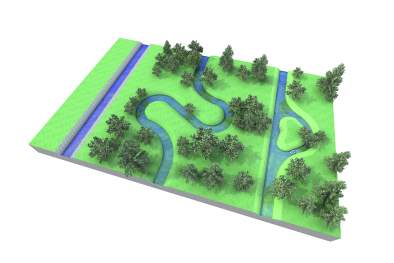The goal of the Integrated Drought Management Programme in Central and Eastern Europe (IDMP CEE) is to test concrete measures for drought management plans. There are six different demonstration projects up and running in within the frame of IDMP CEE. By the end of this year, experts within each of the projects will meet and discuss the progress of their work and set up recommendations for policy making on all levels.
One of the demonstration projects, led by GWP Poland, deals with small water retention to improve the water holding potential of landscapes, and to increase resilience against the effects of climate change. Such measures include small dikes and polders, restoration of wetlands and changes in the forest and agricultural practices.
The University of Life Sciences in Warsaw and GWP Poland jointly organized the first international workshop on 28-29 October in Warsaw. It brought together four partners from Hungary, Poland, Slovakia and Slovenia involved in a small water retention demonstration project. 
The main output of this demonstration project will be technical guidelines for individuals, civil society and policy makers, on how to plan and construct different kinds of small water retention measures that lower flood risk and store water for dry periods.
During the preparation phase, demonstration project experts analysed programmes and measures that can be considered as small retention measures in each of the four countries. However, small water retention still needs a common definition. The experts therefore discussed how to define measures that collect water on a smaller scale and make it available at later stage for different purposes, especially in the case of drought.
Activity leader Dr Tomasz Okruszko emphasized, "Hungary, Poland, Slovakia and Slovenia cover four main climatic and topographic types, ranging from highlands, lowlands, continental to the Mediterranean. In this way zooming out results on regional scale would be an easy step".
The second day of the workshop was devoted to drafting main chapters of guidelines and discussion about the content. The guidelines will define small retention measures and their purpose. A major part of the guidelines will be a small retention cookbook, focused on planning for policy makers and knowledge exchange through case studies from the whole region.
Small retention is often considered only as a flood protection measure; however, the experts agreed that floodwater stored by small retention dikes and polders is also an important source of water for ecosystems, agriculture and forestry during drought in river basins.

IDMP CEE supports governments of Bulgaria, the Czech Republic, Hungary, Lithuania, Moldova, Poland, Romania, Slovakia, Slovenia and Ukraine in a development of drought management policies and plans. It also builds capacity of stakeholders at different levels for proactive integrated drought management approach and tests innovative approaches for future drought management plans.
For more information about CEE IDMP, please contact Sabina Bokal, Programme Manager, email: idmp.sabina[at]gmail.com
Photo credits: Limnos
